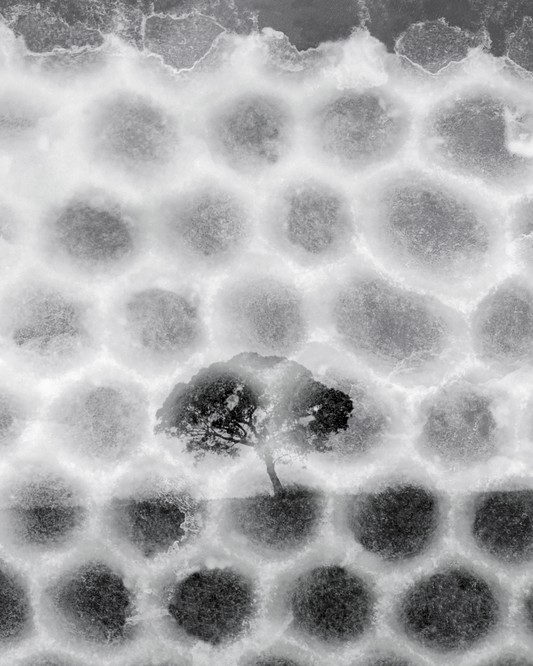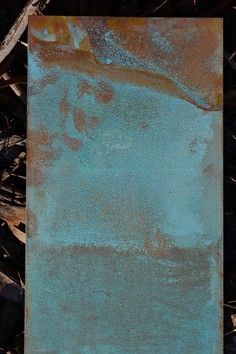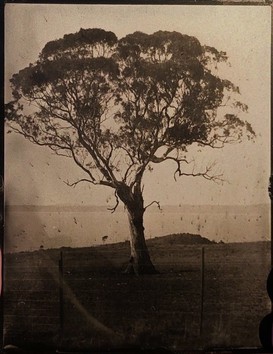Sammy Hawker
Conversations with bees
22 nov. 2024 — 1 feb. 2025
Sammy Hawker
Conversations with bees

22 nov. 2024 — 1 feb. 2025
Image: Sammy Hawker, Honeycomb #3, 2023, pigment inkjet print on archival cotton rag, 110 x 136cm. Image courtesy and © the artist.
Image: Sammy Hawker, Honeycomb #3, 2023, pigment inkjet print on archival cotton rag, 110 x 136cm. Image courtesy and © the artist.
Sammy Hawker
Conversations with bees
22 nov. 2024 — 1 feb. 2025
Kamberri/Canberra-based artist Sammy Hawker explores the potential of reciprocal engagements between human and more-than-human worlds. Hawker’s multi-disciplinary practice consistently embraces text, photography and moving image. These works form part of a vast and ongoing archive documenting sites and moments of exchange.
Over the past few years Hawker has been co-creating imagery with two hives of honeybees cared for by local beekeeper Oli Chiswell on Ngunawal/Gundungurra Country. These beehives live to the north of Ngungara/Weereewa/Lake George, an endorheic lake which periodically fills and then empties of water.
Conversations with bees evolved from research around the European ritual ‘telling the bees’, where honeybees are told of recent deaths in a beekeeper’s household. It is believed if the bees are not informed they might leave the hive and follow the deceased into the afterlife. It is understood the practice has its origins in Celtic mythology where bees are regarded as messengers between the natural world and the spirit realm; a portal connecting the living and the dead.
The photographs Hawker delivers to the hives are of ecologically disturbed sites from around Ngungara/Weereewa/Lake George, ‘informing’ the bees of the mass disappearance of more-than human lives in the roar of the Anthropocene.
Conversing with bees is a practice of recognising and grieving the losses of a changed and changing world. Like the ever-shifting shoreline of Ngungara/Weereewa/Lake George, the exhibition Conversations with bees is a reflection on liminal or in-between spaces, and a consideration of how European mythology has become entangled within the Australian landscape, sitting ajar to Indigenous Australians own deep stories and knowledge of Country.
Related Events
Panel chat: Sammy Hawker, Jess Ward-Jones and Cormac Farrell on bees
Chromatograms with Sammy Hawker
Exhibition opening












12
Installation view Sammy Hawker ‘Conversations with bees’ featuring exhibition introductory text; Sammy Hawker ‘Honeycomb No 3’, pigment inkjet print on archival cotton rag; ‘Telling the Bees #2’, pigment inkjet print on archival cotton rag; ‘Telling the Bees #1’; pigment inkjet print on archival cotton rag; ‘Honeycomb #2’, pigment inkjet print on archival cotton rag; ‘Conversations with bees’, single channel video and ‘Chromatogram of Dead Bees’, fijitran print framed in custom-built lightbox, courtesy of the artist. Photograph: Silversalt Photography.
Installation view Sammy Hawker ‘Conversations with bees’ featuring Sammy Hawker ‘Honeycomb No 3’, pigment inkjet print on archival cotton rag; ‘Telling the Bees #2’, pigment inkjet print on archival cotton rag; ‘Telling the Bees #1’’; pigment inkjet print on archival cotton rag; ‘Honeycomb #2’, pigment inkjet print on archival cotton rag; ‘Conversations with bees’, single channel video and ‘Chromatogram of Dead Bees’, fijitran print framed in custom-built lightbox, courtesy of the artist. Photograph: Silversalt Photography.
Installation view Sammy Hawker ‘Conversations with bees’ featuring exhibition introductory text and Sammy Hawker ‘Honeycomb No 3’, pigment inkjet print on archival cotton rag, courtesy of the artist. Photograph: Silversalt Photography.
Installation view Sammy Hawker ‘Conversations with bees’ featuring Sammy Hawker ‘Honeycomb No 3’, pigment inkjet print on archival cotton rag; ‘Telling the Bees #2’, pigment inkjet print on archival cotton rag; ‘Telling the Bees #1’; pigment inkjet print on archival cotton rag; ‘Honeycomb #2’, pigment inkjet print on archival cotton rag, courtesy of the artist. Photograph: Silversalt Photography.
Installation view Sammy Hawker ‘Conversations with bees’ featuring Sammy Hawker, ‘Telling the Bees #2’, pigment inkjet print on archival cotton rag; Telling the Bees #1; pigment inkjet print on archival cotton rag, courtesy of the artist. Photograph: Silversalt Photography.
Installation view Sammy Hawker ‘Conversations with bees’ featuring Sammy Hawker, ‘Conversations with bees’, single channel video and ‘Chromatogram of Dead Bees’, fijitran print framed in custom-built lightbox, courtesy of the artist. Photograph: Silversalt Photography.
Installation view Sammy Hawker ‘Conversations with bees’ featuring Sammy Hawker, ‘Conversations with bees’, single channel video and ‘Chromatogram of Dead Bees’, fijitran print framed in custom-built lightbox, courtesy of the artist. Photograph: Silversalt Photography.
Installation view Sammy Hawker ‘Conversations with bees’ featuring Sammy Hawker, ‘Chromatogram of Dead Bees’, fijitran print framed in custom-built lightbox, courtesy of the artist. Photograph: Silversalt Photography.
Installation view Sammy Hawker ‘Conversations with bees’ featuring Sammy Hawker, ‘Chromatogram of Scotch Thistle’, diptych, pigment inkjet print on archival cotton rag; ‘Chromatogram of Blackberry Thorn, diptych, ; pigment inkjet print on archival cotton rag and Chromatagram of Four-leaf Clover’, pigment inkjet print on archival cotton rag, courtesy of the artist. Photograph: Silversalt Photography.
Installation view Sammy Hawker ‘Conversations with bees’ featuring Sammy Hawker, ‘Chromatogram of Scotch Thistle’, diptych, pigment inkjet print on archival cotton rag, courtesy of the artist. Photograph: Silversalt Photography.
Installation view Sammy Hawker ‘Conversations with bees’ featuring Sammy Hawker, Chromatogram of Blackberry Thorn, diptych, ; pigment inkjet print on archival cotton rag, courtesy of the artist. Photograph: Silversalt Photography.
Installation view Sammy Hawker ‘Conversations with bees’ featuring Sammy Hawker, Chromatagram of Four-leaf Clover’, pigment inkjet print on archival cotton rag, courtesy of the artist. Photograph: Silversalt Photography.
Image: Sammy Hawker, Honeycomb #3, 2023, pigment inkjet print on archival cotton rag, 110 x 136cm. Image courtesy and © the artist.
Sammy Hawker
Conversations with bees
22 nov. 2024 — 1 feb. 2025
Kamberri/Canberra-based artist Sammy Hawker explores the potential of reciprocal engagements between human and more-than-human worlds. Hawker’s multi-disciplinary practice consistently embraces text, photography and moving image. These works form part of a vast and ongoing archive documenting sites and moments of exchange.
Over the past few years Hawker has been co-creating imagery with two hives of honeybees cared for by local beekeeper Oli Chiswell on Ngunawal/Gundungurra Country. These beehives live to the north of Ngungara/Weereewa/Lake George, an endorheic lake which periodically fills and then empties of water.
Conversations with bees evolved from research around the European ritual ‘telling the bees’, where honeybees are told of recent deaths in a beekeeper’s household. It is believed if the bees are not informed they might leave the hive and follow the deceased into the afterlife. It is understood the practice has its origins in Celtic mythology where bees are regarded as messengers between the natural world and the spirit realm; a portal connecting the living and the dead.
The photographs Hawker delivers to the hives are of ecologically disturbed sites from around Ngungara/Weereewa/Lake George, ‘informing’ the bees of the mass disappearance of more-than human lives in the roar of the Anthropocene.
Conversing with bees is a practice of recognising and grieving the losses of a changed and changing world. Like the ever-shifting shoreline of Ngungara/Weereewa/Lake George, the exhibition Conversations with bees is a reflection on liminal or in-between spaces, and a consideration of how European mythology has become entangled within the Australian landscape, sitting ajar to Indigenous Australians own deep stories and knowledge of Country.
Related Events
Panel chat: Sammy Hawker, Jess Ward-Jones and Cormac Farrell on bees
Chromatograms with Sammy Hawker
Exhibition opening












12
Installation view Sammy Hawker ‘Conversations with bees’ featuring exhibition introductory text; Sammy Hawker ‘Honeycomb No 3’, pigment inkjet print on archival cotton rag; ‘Telling the Bees #2’, pigment inkjet print on archival cotton rag; ‘Telling the Bees #1’; pigment inkjet print on archival cotton rag; ‘Honeycomb #2’, pigment inkjet print on archival cotton rag; ‘Conversations with bees’, single channel video and ‘Chromatogram of Dead Bees’, fijitran print framed in custom-built lightbox, courtesy of the artist. Photograph: Silversalt Photography.
Installation view Sammy Hawker ‘Conversations with bees’ featuring Sammy Hawker ‘Honeycomb No 3’, pigment inkjet print on archival cotton rag; ‘Telling the Bees #2’, pigment inkjet print on archival cotton rag; ‘Telling the Bees #1’’; pigment inkjet print on archival cotton rag; ‘Honeycomb #2’, pigment inkjet print on archival cotton rag; ‘Conversations with bees’, single channel video and ‘Chromatogram of Dead Bees’, fijitran print framed in custom-built lightbox, courtesy of the artist. Photograph: Silversalt Photography.
Installation view Sammy Hawker ‘Conversations with bees’ featuring exhibition introductory text and Sammy Hawker ‘Honeycomb No 3’, pigment inkjet print on archival cotton rag, courtesy of the artist. Photograph: Silversalt Photography.
Installation view Sammy Hawker ‘Conversations with bees’ featuring Sammy Hawker ‘Honeycomb No 3’, pigment inkjet print on archival cotton rag; ‘Telling the Bees #2’, pigment inkjet print on archival cotton rag; ‘Telling the Bees #1’; pigment inkjet print on archival cotton rag; ‘Honeycomb #2’, pigment inkjet print on archival cotton rag, courtesy of the artist. Photograph: Silversalt Photography.
Installation view Sammy Hawker ‘Conversations with bees’ featuring Sammy Hawker, ‘Telling the Bees #2’, pigment inkjet print on archival cotton rag; Telling the Bees #1; pigment inkjet print on archival cotton rag, courtesy of the artist. Photograph: Silversalt Photography.
Installation view Sammy Hawker ‘Conversations with bees’ featuring Sammy Hawker, ‘Conversations with bees’, single channel video and ‘Chromatogram of Dead Bees’, fijitran print framed in custom-built lightbox, courtesy of the artist. Photograph: Silversalt Photography.
Installation view Sammy Hawker ‘Conversations with bees’ featuring Sammy Hawker, ‘Conversations with bees’, single channel video and ‘Chromatogram of Dead Bees’, fijitran print framed in custom-built lightbox, courtesy of the artist. Photograph: Silversalt Photography.
Installation view Sammy Hawker ‘Conversations with bees’ featuring Sammy Hawker, ‘Chromatogram of Dead Bees’, fijitran print framed in custom-built lightbox, courtesy of the artist. Photograph: Silversalt Photography.
Installation view Sammy Hawker ‘Conversations with bees’ featuring Sammy Hawker, ‘Chromatogram of Scotch Thistle’, diptych, pigment inkjet print on archival cotton rag; ‘Chromatogram of Blackberry Thorn, diptych, ; pigment inkjet print on archival cotton rag and Chromatagram of Four-leaf Clover’, pigment inkjet print on archival cotton rag, courtesy of the artist. Photograph: Silversalt Photography.
Installation view Sammy Hawker ‘Conversations with bees’ featuring Sammy Hawker, ‘Chromatogram of Scotch Thistle’, diptych, pigment inkjet print on archival cotton rag, courtesy of the artist. Photograph: Silversalt Photography.
Installation view Sammy Hawker ‘Conversations with bees’ featuring Sammy Hawker, Chromatogram of Blackberry Thorn, diptych, ; pigment inkjet print on archival cotton rag, courtesy of the artist. Photograph: Silversalt Photography.
Installation view Sammy Hawker ‘Conversations with bees’ featuring Sammy Hawker, Chromatagram of Four-leaf Clover’, pigment inkjet print on archival cotton rag, courtesy of the artist. Photograph: Silversalt Photography.

